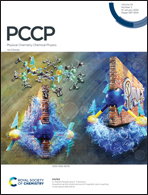Coexistence of intrinsic room-temperature ferromagnetism and piezoelectricity in monolayer BiCrX3 (X = S, Se, and Te)†
Abstract
Two-dimensional (2D) materials with intrinsic ferromagnetism and piezoelectricity have received growing attention due to their potential applications in nanoscale spintronic devices. However, their applications are highly limited by the low Curie temperatures (TC) and small piezoelectric coefficients. Here, using first-principles calculations, we have successfully predicted that BiCrX3 (X = S, Se, and Te) monolayers simultaneously possess ferromagnetism and piezoelectricity by replacing one layer of Bi atoms with Cr atoms in Bi2X3 monolayers. Our results demonstrate that BiCrX3 monolayers are not only intrinsic ferromagnetic semiconductors with indirect band gaps, adequate TC values of higher than 300 K, and significant out-of-plane magnetic anisotropic energies, but also exhibit appreciable in-plane and out-of-plane piezoelectricity. In particular, the in-plane piezoelectric coefficients of BiCrX3 monolayers with ABCAB configuration are up to 15.16 pm V−1, which is higher than those of traditional three-dimensional piezoelectric materials such as α-quartz. The coexistence of ferromagnetism and piezoelectricity in BiCrX3 monolayers gives them promising applications in spintronics and nano-sized sensors.



 Please wait while we load your content...
Please wait while we load your content...